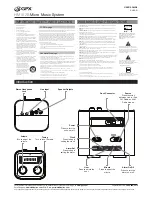
(36) 1/2, 3/4, L/R, MONO (ASSIGN)
Like the channel assign switches, these buttons determine the bus assignment of the input
signal. They determine where the return signal is being sent.
(37)
BAL/PAN
This control determines the placement of the signal in its assigned bus. Rotating the control
counterclockwise (L) sends more signal to the LEFT output and odd-numbered SUBS;
rotating clockwise (R) sends more signal to the RIGHT output and even-numbered SUBS.
The C position sends equal amounts to each.
(38)
LEVEL
This control determines the level of the signal being sent to its assigned bus(es). It functions
similarly to the CHANNEL FADERS (16).
(39) MUTE
SWITCH/MUTE-CLIP LED
Like the other mutes on the console, this switch interrupts the input signal being sent to the
bus(es). Red LED illumination indicates activation. When MUTE is not engaged, the LED
functions as a clip (PK) indicator that illuminates at 2 dB below clipping.
(40) AFL SWITCH/AFL-SIGNAL LED
This switch directs the post-fader (AFL) signal to the HEADPHONE OUTPUT (42), and to the
AFL/PFL LEVEL DISPLAY (45). An adjacent LED illuminates to signify this selection. If AFL is
not selected, the LED will blink as an indication of signal presence (-20 dBu).
(41) PHANTOM
POWER
These switches apply power (+48 V DC) to the MIC inputs (6) on CHANNELS 1–16 and
17–24 respectively (1–24 on the AAM 2443 and 25–32 on the AAM 3243). This feature
provides power to microphones that need an external power source. These switches are
recessed into the console and require a small “tool” to activate. If PHANTOM POWER is
used, do not connect unbalanced dynamic microphones or other devices that cannot handle
this voltage to the XLR inputs. (Some wireless receivers may be damaged. Consult their
manuals.) A regular low-impedance mic such as the PVM
™
22 will not be harmed. The LINE
inputs (2) are not connected to the +48 V supply and are safe for balanced or unbalanced
inputs. An adjacent LED will illuminate when PHANTOM POWER is activated on its
respective channels.
(42) HEADPHONE
OUTPUT
This stereo output jack (TRS) provides the signal to drive headphones. Signal to this output is
L/R unless AFL or PFL is activated.
(43) HEADPHONE
LEVEL
This control adjusts the volume of the signal being sent to the HEADPHONE OUTPUT (42).
(44) LEFT/RIGHT
LEVEL DISPLAYS
These indicators graphically display the signal level being sent to the LEFT or RIGHT outputs
(L, R). Signal is sampled at the summing amp and post-master faders to monitor clipping
throughout the Left/Right and MONO MASTER section. The CLIP indicator will illuminate
when signal approaches (-2 dB) clipping.
NOTE:
CLIP LED can illuminate before the rest of the array indicating the summing amp is
clipping.
(45) MONO
—
AFL/PFL LEVEL DISPLAY
This indicator graphically displays the signal level being sent to the MONO output. When any
AFL/PFL switch on the mixer is activated, this display indicates the signal level being sent to
the AFL/PFL bus. The AFL/PFL indicator flashes if either mode (AFL or PFL) is selected.
11






































